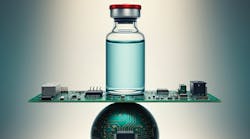The pharma industry has always been complex, so technological advances that can enhance workflow efficiencies and promote new breakthroughs are always welcomed. Consequently, the industry faces a state of flux where technology is pushing the traditional boundaries of drug development, manufacturing and regulation to new limits — but mostly for the better.
Artificial intelligence (AI) signifies the arrival of the technological revolution. Through the deployment of sophisticated machine learning and deep learning techniques, algorithms and extensive datasets are enhancing success rates to boost efficiencies across a range of processes. Advances in automation and robotics mean that intelligent machinery now automates previously manual jobs, with analytics utilizing the cloud to provide real-time data to ensure optimal performance and avoid unwanted deviation from manufacturing protocols.
These technologies are resulting in a series of significant pharmaceutical innovations to provide hope for unmet clinical needs through personalized treatment plans. Furthermore, this has stirred a demand for innovations such as injectable biologics, which are utilizing new drug technologies for patient convenience.
With many complexities still existing across the pharma supply chain — from manufacturing to post-market surveillance — new technologies are presenting additional opportunities to address and improve upon these challenges.
From drug containment solutions to modern manufacturing technologies, the latest technological advancements are not just changing the industry but also setting new standards for what’s possible in health care.
Drug containment solutions
Drug containment systems continue to play a vital role in the delivery of lifesaving drugs to patients.
Whilst the development of new drugs often exhibits complex analytical and processing challenges, safely storing and delivering sensitive biologics to patients presents another. As such, packaging manufacturers are focusing on providing innovative solutions to address this challenge, while demonstrating additional time-saving and cost-cutting benefits.
Using advanced processing technologies, specialist manufacturers are offering ready-to-use pre-sterilized primary containment units — such as syringes, vials or cartridge formats — that only require filling by the manufacturer.
In an era where the demand for pharmaceutical products can fluctuate in response to market needs, ready-to-use drug containment solutions offer flexibility and versatility in batch size, but without the compromise of quality or efficiency.
Whereas production volumes should be flexible, patient quality and safety should not. The innovative designs of these drug containment solutions ensure that all containers are separated through the use of secondary packaging, minimizing the risk of contamination while maintaining the integrity of the pre-sterilized containers during transportation and handling. With a streamlined production process, the increased efficiency results in a shorter time period between production and distribution, ensuring pharma manufacturers can deliver drugs to patients faster than ever before.
Although the above points are clearly beneficial, cost is usually the most important consideration. These customizable drug containment solutions typically result in significant cost savings through the elimination of in-house processes such as washing, depyrogenation and sterilization, and associated labor and equipment requirements.
AI and machine learning
The pharmaceutical landscape is undergoing a seismic shift, thanks to the integration of artificial intelligence, machine learning (ML) and deep learning (DL). These technologies are no longer buzzwords but practical applications that mimic human intelligence in tasks such as data analysis, decision making and problem solving — often doing so faster, more accurately and with greater cost effectiveness.
For instance, the use of computational technologies in the drug discovery process is facilitating the identification of potential genes or proteins as targets for new drugs. Through the analysis of extensive biological datasets and the prediction of molecular interactions, the time taken to screen potential drug candidates is significantly reduced during the initial phases of drug development.
In both preclinical and clinical research phases, AI is improving efficiency and safety by forecasting the toxicity of compounds, reducing the reliance on animal testing while enhancing safety measures.
In addition, the patient recruitment process for clinical trials is being optimized. Through the analysis of intricate data, AI enables the simulation of trial scenarios and the fine-tuning of factors (such as dosage and treatment length) to ensure the selection of the most appropriate participants for trials.
The same technology is also helping to transform pharma manufacturing processes.
Visual inspection technologies have emerged as pivotal tools in improving manufacturing precision via the integration of AI visual inspection units across the production line.
Historically, pharma products have presented significant challenges to visual inspection systems that usually lead to erroneous interpretations of presumed defects. Conventional methods may inaccurately categorize harmless attributes like cosmetic flaws or air bubbles — particularly in suspension or lyophilized cake form — as contaminating particles, resulting in the need for reinspections and a time and cost expense.
However, the integration of cloud-based AI platforms utilizing ML and DL models provides a range of additional benefits:
Enhanced inspection performance: Detects product cosmetic defects and particle inspections with increasing accuracy, whilst concurrently minimizing the number of false rejections
Cost efficiency: Cuts costs by obviating the need for reinspecting gray items and significantly reducing the time spent on optimizing and parameterizing machines
Cloud-based ownership: The cloud-based nature eradicates disk space limitations and high maintenance costs, while still taking advantage of secure data protection, encryption and traceability of data
Enhancing inspection accuracy increases defect detection and reduces incorrect rejection rates, thereby improving overall quality. It also reduces costs for high-value, small-scale batch production, as well as for high-volume and lower-value drugs. Through the coupling of existing manufacturing processes with AI and robotics, it is possible to fully automate batch production and improve the output of manufacturing lines.
Another application promising to unlock new opportunities is digital twin technology. The software tool can simulate the analysis and outcomes of various inspection stations installed into the machine, offering the same interface and the same potential as the machine vision system. The technology processes images captured by the machine (during testing or production phases) and enables the refinement of existing recipes or the creation of new ones. It also facilitates the reprocessing of images from an entire batch to monitor waste trends as parameters are adjusted — all without halting production.
Container traceability tools
Container traceability plays an important role in ensuring the integrity and safety of products across the supply chain. Through the implementation of quick response (QR) codes and radio-frequency identification (RFID) technology on pharmaceutical glassware, increased levels of traceability and control can be achieved.
QR codes and RFID tags act as digital fingerprints for each container to store essential data such as origin, batch number and expiration date, and offer real-time tracking throughout internal manufacturing processes.
This integration of container traceability technology with other technologies opens new avenues for innovation and efficiency. For instance, combining insights from visual inspection tools with container traceability can provide insights into specific manufacturing failures. Or when combined with AI-driven analytics, data collected can be analyzed to predict and prevent disruptions prior to manufacturing.
Looking ahead, additional integration with blockchain technology could offer an immutable ledger of a container’s journey, ensuring transparency and compliance with regulatory standards.
Data-driven decision-making
These technological innovations outline just some of the ways that the pharma industry is shifting from reactive to proactive strategies. The result: Enhanced, patient-centered solutions that elevate the standard of care and overall patient well-being.
AI’s predictive analytics will lead to more personalized medicine through the tailoring of treatments aligned to individual genetic profiles, combined with AI’s self-learning capabilities providing insights into improvements and efficiencies across supply chains.
Innovative drug containment solutions will allow manufacturers to provide patients with drug delivery systems that are more convenient for the user, while simplifying the manufacturing process for pharma companies and contract manufacturers. By combining drug containment systems with new traceability technologies, manufacturers will have greater confidence in the overall quality of their products, while providing additional safety reassurance to end users.
A commonality between the success of all of the technologies discussed in this article will rely on data. Data-driven decision-making will enable optimized drug development and manufacturing processes to enhance overall efficiency. However, harnessing this data deluge necessitates robust data management and analytics capabilities to ensure that drugs meet the highest quality standards.
Sustainable manufacturing practices are also coming to the fore, driven by both regulatory pressures and a societal push towards eco-friendly practices. New technologies are actively aiding sustainability through efficiency and further using data to uncover new opportunities for improvements.
Future outlook
With the pharma industry being on the cusp of a technological revolution, innovations will transform the industry into one that is more patient-centric, data-driven and sustainable.
However, the path forward is not straightforward. Regulatory hurdles are a significant concern, as the industry must navigate a complex set of standards that vary across different markets. Ensuring compliance while fostering innovation requires a delicate balance and a proactive approach to regulatory engagement.
Data privacy and security are also critical. As health care becomes increasingly digitized, protecting sensitive patient information against breaches and unauthorized access is paramount, with a necessity for robust cybersecurity measures and a continuous reassessment of data protection strategies.
Despite these challenges, the outlook for technology in the pharma industry is positive. These technologies are not just incremental improvements but are fundamental drivers of change and are poised to bring about a new era of innovation across all aspects of the pharma industry.
The successful integration of these technologies relies on collaboration among all stakeholders. Pharma companies, tech firms, regulatory bodies and health care providers must prioritize the challenge of working together for the sake of all parties involved.
If these challenges can be met, the future of the pharma industry looks not only promising but revolutionary, with technology driving progress and patient care to new heights.







